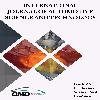Ali Fuat Ergenc, Alp Tekin Ergenc, Sefa Kale, Ilknur G. Sahin, Kerem Dagdelen, Volkan Pestelli, Orcun Yontem, Bahadir Kuday
REDUCED WEIGHT AUTOMOTIVE BRAKE PEDAL TEST & ANALYSIS
REDUCED WEIGHT AUTOMOTIVE BRAKE PEDAL TEST & ANALYSIS
Currently, automotive industry continues to strive for light weight vehicle for improving fuel efficiency and emission reduction. It is crucial to design vehicles with an optimum weight for a better performance of the car. In this field, which has boundaries with fixed standards and regulations, manufacturers continue to work on characteristics, structures and types of the material to develop new components, which have same safety specifications but cheaper and lighter than current products.
Keywords:
: Brake pedal, strength analysis, fatigue life, finite element analysis,
___
- [1] Cerilles, J.T., Measurement and Control of Brake Pedal Feel Quality in Automobile Manufacturing, M.Sc Thesis, MIT, 2005
- [2] R. Limpert, Brake Design and Safety, second ed., Society of Automotive engineers, 1999
- [3] J. Setien,J., Gonzalez, J.J., Polanco J.A., Cracking diagnostics of brake pedals during press forming operations, Engineering Failure Analysis Vol. 7 pp. 69-74,2000
- [4] Sapuan, S.M., A Conceptual Design of the Concurrent Engineering Design System for Polymeric-Based Composite Automotive Pedals, American Journal of Applied Sciences 2(2): 514-525, 2005
- [5] Lee,S.H.,Park, T.W., Jung, I.H., Seo, J.H., Development of Automotive Braking Performance Analysis Program Considering Dynamic Characteristics, Trans. KSAE, Vol. 12, No. 2, pp. 175-181, 2004
- [6] Kim, J. D., A Study on Load Analysis and Durability Test Condition Evaluation of Automotive Brake Pedal, M. S. Thesis, Changwan National University, 2004
- [7] B. W. Noh, Y. W. Choi, S. I. Bae, "A Study on Load Analysis and Durability Test Condition of Automobile Brake Pedal ", Key Engineering Materials, Vols. 324-325, pp. 1273-1276, 2006
- [8] Budynas-Nisbett, Shigley’s Mechanical Engineering Design, eight ed., Mcgraw Hill, 2006
- Yayın Aralığı: Yılda 4 Sayı
- Başlangıç: 2016
- Yayıncı: Otomotiv Mühendisleri Derneği
